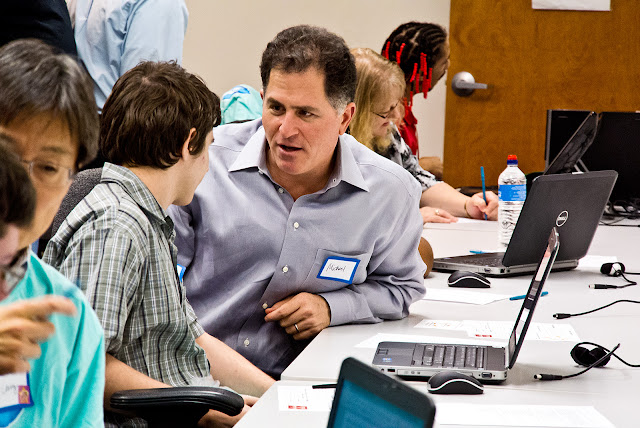Michael Dell Volunteering at Austin Easter Seals.
Shot with a Nikon V1. Years ago.
©2010 Kirk Tuck
Just a few blog reminders for those who visit infrequently, are new to the blog:
I receive no money or free gear from any of the companies whose products I discuss here, with the following (past) exceptions: I was a member of Samsung's Imagelogger program and received several cameras and lenses in exchange for posting images (but not reviews or commentary!) taken with the gear. They (Samsung) seem to have exited the camera business last year. At no time did anyone at Samsung request, cajole, plead, beg or ask me to write anything at all about their products, nor did they offer to pay me for any sort of endorsement or online discussion of their products.
The Cactus company sent me three triggers and one flash to test and review. I was under no obligation to review the products. I did so because they worked well and represented a fair investment for users who work with small flashes.
In 2009 Olympus paid me to present several demonstrations using their photographic products to a live audience at a Photo Expo here in Austin. I have received no additional payments from them and, while I have been loaned equipment to review it was promptly returned. Olympus have never tried to influence my reviews nor have they paid me to make any assertions about their products on any of my blogs.
I have shot with Canon, Nikon, Olympus, Panasonic and Sony in the past three years and have not received from any of them, or their agents or assigns, any gear, money, consideration, junkets, travel or even swag. Nothing. Nada. Not from any of them. Not even a promotional coffee cup. (Cheap bastards).
I am a Craftsy.com instructor and believe that the courses I've taught are good and have value to photographers who are learning the craft. I use the blog from time to time to promote these classes. They are offered with a "no questions asked, money back guarantee."
Our blog site, like almost every other blog site in the photography niche, is an Amazon affiliate. We sometimes link products I am writing about back to Amazon. If you click on the link and go through to Amazon and buy something Amazon gives me a commission on that sale that does not effect the price of the product or service to you.
=================================================
=================================================
Why am I writing this? Disclosure is always good. And I'm getting tired of anyone who disagrees with something I've written immediately stating that, "Tuck switches systems because he's a paid shill for XXXXX." Anyone who thinks the camera market is full of people getting paid to use gear from camera makers is delusional. There are a few people who get consideration, assistance with travel, and the use of the latest gear in exchange for their honest reviews and assessments but I bet we could count those U.S. photographers on two hands.... And I'm sure not one of them.
All the equipment in my studio right now; today, was bought and paid for either from Precision Camera here in Austin or came from Amazon.com. I neither asked for, nor have been extended, any privileged pricing from either merchant. My average monthly income from this blog for the past year is approximately = 25 Starbucks Venti Lattes (per month). The amount of time I spend writing blog posts and responding to them is approximately 60 hours a month. You do the math.
I currently derive the majority of my income from creating photographs which I license to clients directly, or through advertising agencies. I write the blog as a way to share images and ideas. It's usually lots of fun for me and I'm met many, many fine people who I would not have known if not for their interest in the blog. The only time I regret having spent the time writing is when someone links to VSL from a forum on a major photographic website and the people there go ballistic because they either disagree or lack the intellectual capability of understanding correctly what they are trying to read. And, of course, the anonymity of the web allows them to be as nasty as they want to be. The unfounded assertions and ad hominem attacks abound. My comment queue goes toxic from time to time. Feels --- not worth the trouble...
Current Status: Happily self employed, financially stable, busy with projects and still buying whatever I want to shoot with. Also, still writing the blog...












